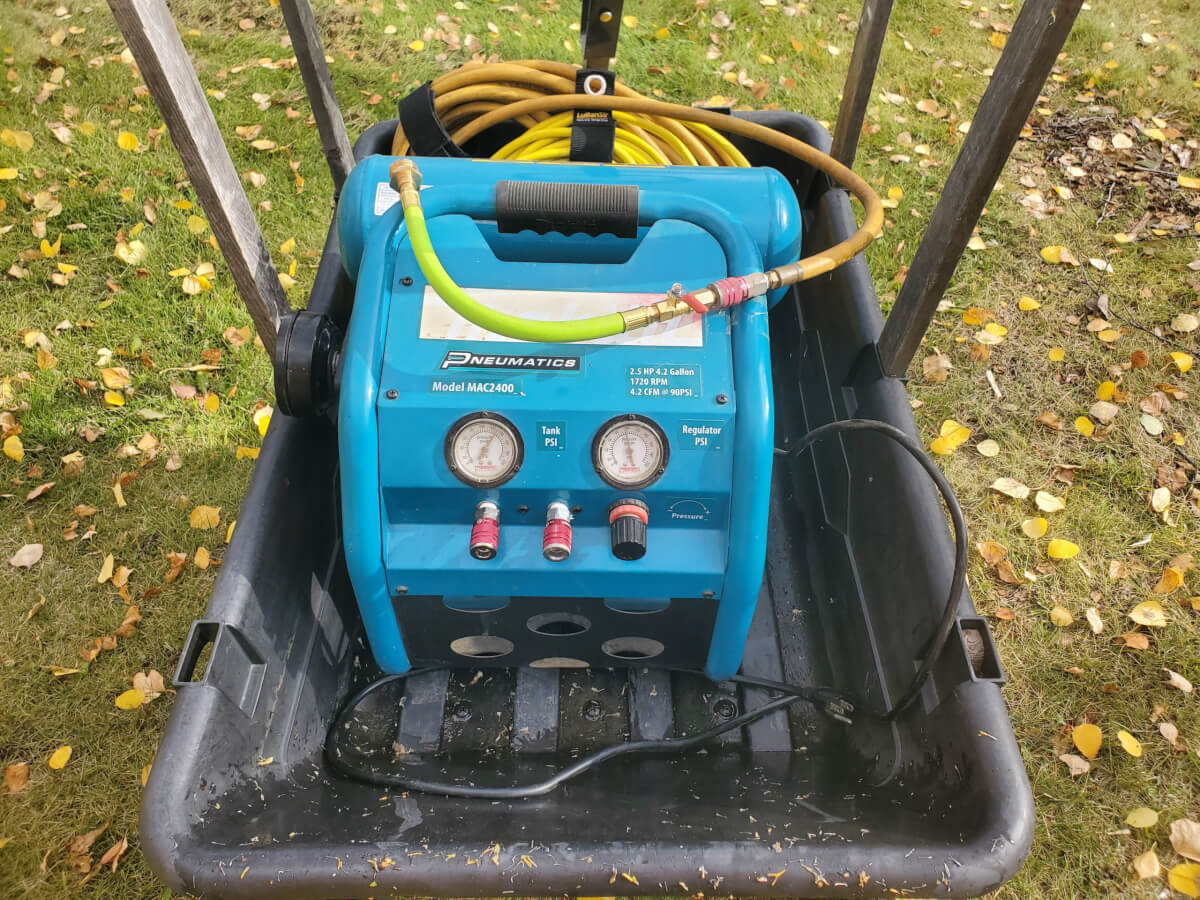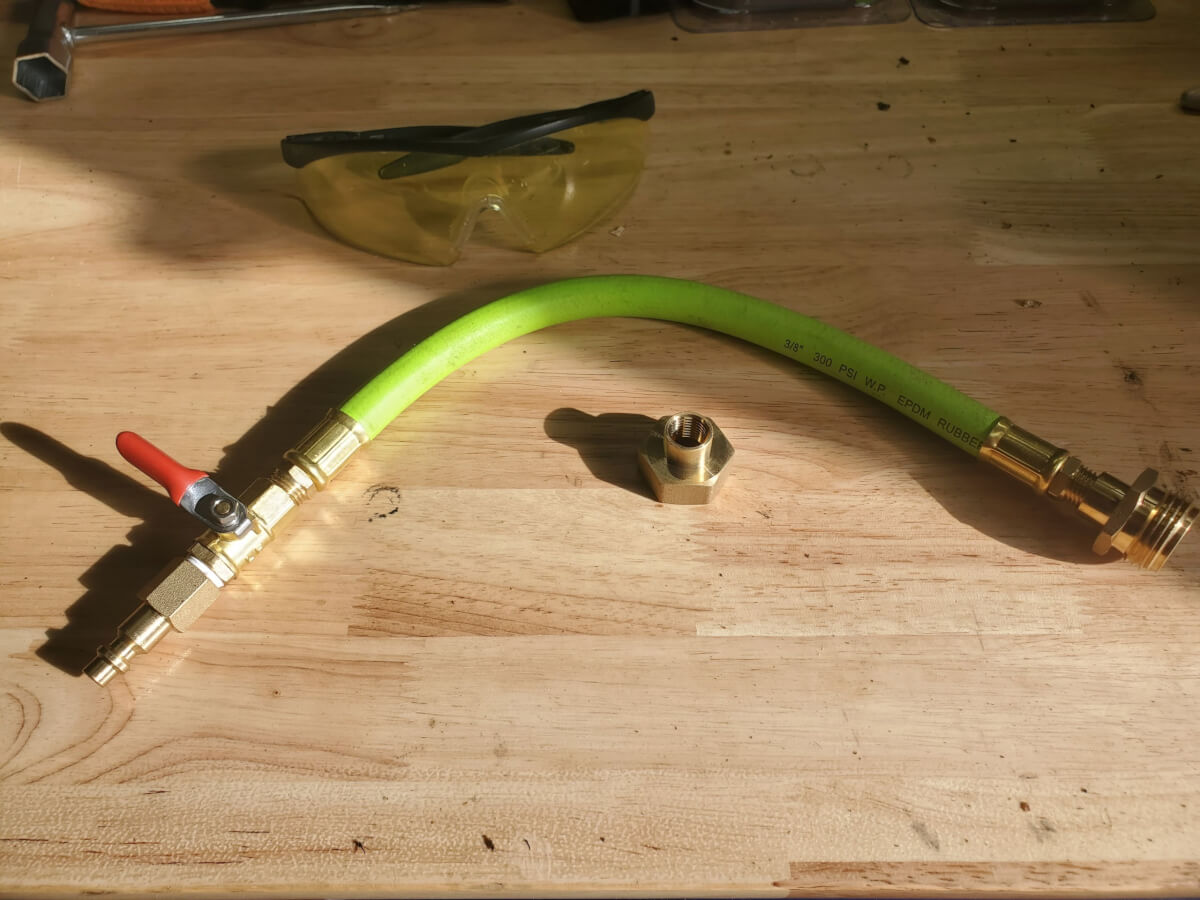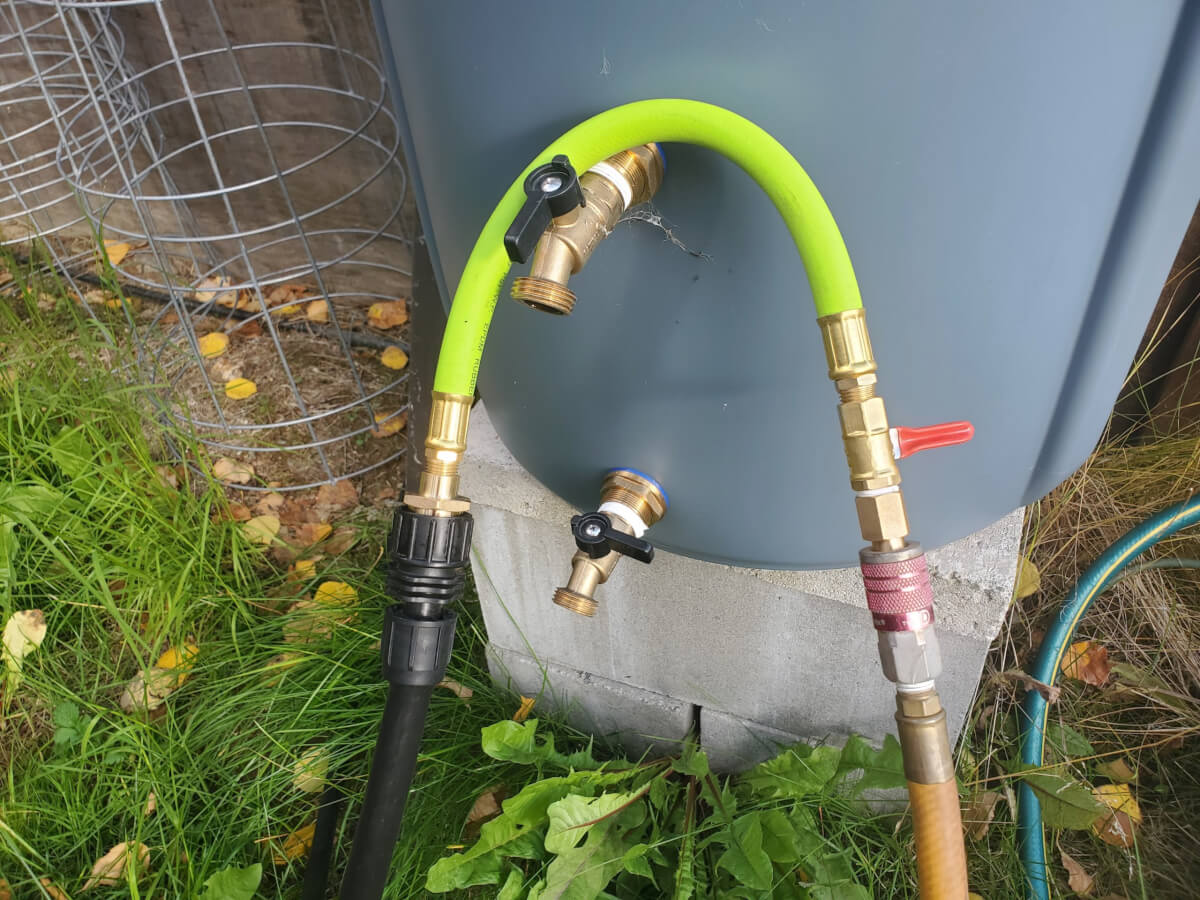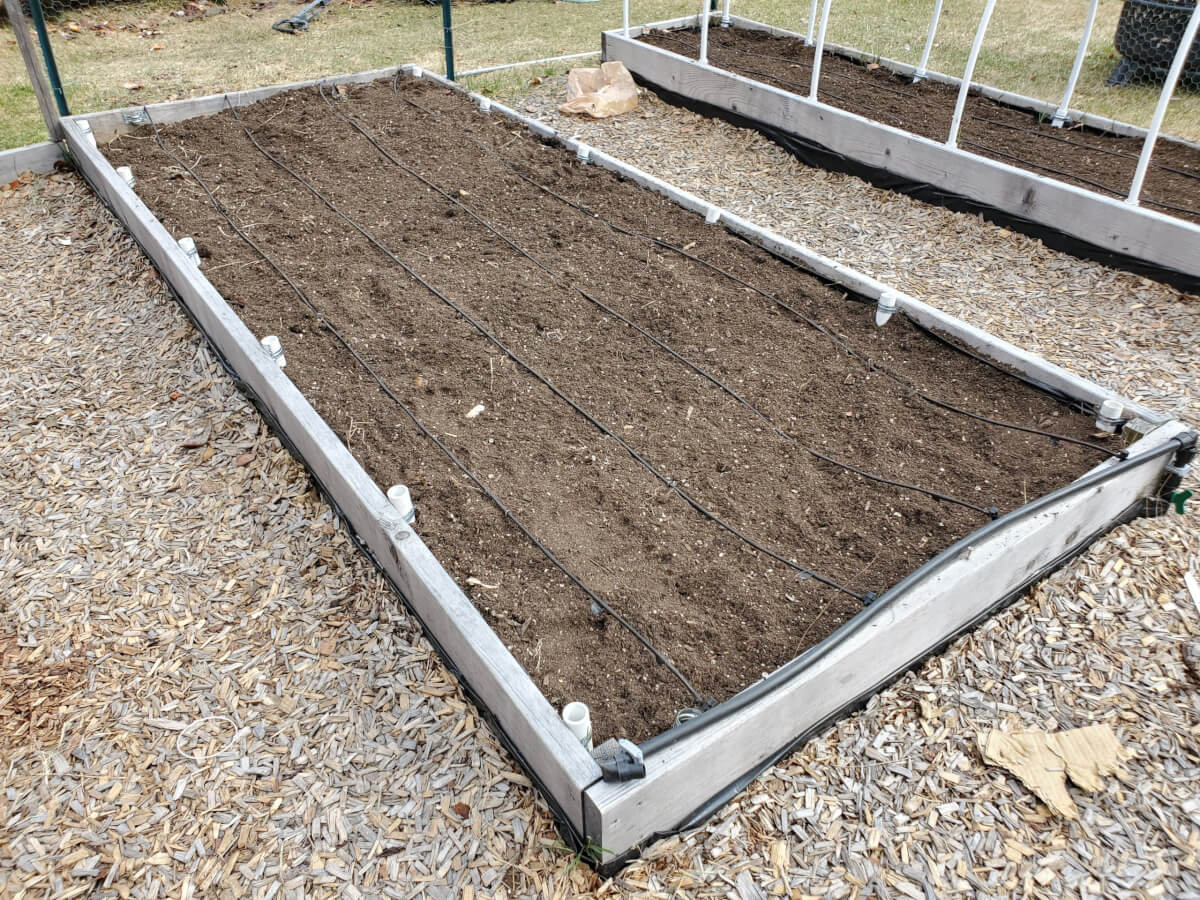This is an important topic to any northern gardener or grower that uses irrigation systems.
You need to know how to winterize your irrigation systems to prevent problems from occurring during the freezing winter months.
Failure to do so can result in expensive and time consuming repairs, sometimes wasting precious water!
Garden Irrigation System Primer
Many gardeners come to the conclusion that permanent or semi-permanent irrigation systems are beneficial. If you are consistently bringing water to your gardens, an irrigation system might help you.
There are many different designs and configuration options for irrigation systems. You can use things like drip tape, emitters, sprayers and sprinklers to irrigate your gardens.
It is fairly typical to use irrigation tubing as a means of delivering water from its source to the destination. This is often semi-rigid piping, commonly known as irrigation tube.
Various fittings can be used to wrap around corners, break out lines and terminate the irrigation line as needed.

We extensively use irrigation systems as it significantly reduces the amount of labor we have to spend watering our gardens. We have several “zones” that allow us to water multiple gardens.
Irrigation systems often contribute to much higher levels of water conservation compared to hose sprayers. It reduces overspray and wasted water on the plant’s leaves, which typically just evaporates.
Since we mostly use rain water catchment to water our gardens, that conservation is important!
The Problem With Northern Garden Irrigation Systems
Irrigation systems are great over the summer! The northern gardener appreciates these systems every day.
However, in northern climates, it is extremely common to see freezing temperatures over the long winter months.
When water freezes, it expands.
This expansion can cause the irrigation lines, fittings and various emitters to crack or break. Ice can cause all sorts of problems in your system.
Quick science break! When water freezes, it forms into an open hexagonal form. This is why it takes more physical space when water is frozen as ice!
Since irrigation systems are often water tight,” the water can’t just naturally escape and is “stuck” in the system.
There might also be natural elevation changes that “trap” water in certain areas of the irrigation system.
The Basics Tools Of Garden Irrigation System Winter Maintenance
We have figured our general preferences of how we like to clear our irrigation lines of water prior to winter setting in. This is how we do it!
There are a few tools that we need.
The first, is an air compressor. Pretty much any air compressor will do, even relatively inexpensive ones. A small one is best, you don’t want to be toting around a massive one! There are no minimum ratings you need to be concerned about. You’ll also need at least a six foot air hose, longer is OK too.

This is our complete irrigation system winterizing kit. We like to load it up in a garden cart to make moving it around much easier. If you have a big air compressor, you might need a lot of air hose!
The second tool you need is called an “RV Winterizing Tool,” sometimes also called a “blowout adapter.” This is a basic adapter that will connect an air compressor hose to various garden hose fittings.

This is a blowout adapter, sometimes also called an RV winterization kit. It adapts an air compressor male or female garden hose threads. It also has a valve that allows introduction of air into hoses and irrigation lines.
In case you aren’t aware, there are various “quick connect” fittings that are used in air hoses and compressors. For the most part, these are commonly standardized, but not in every case.
For the purposes of this discussion, the air connection on your blowout adapter must be compatible with the quick connect on your air hose. We use this style of quick connects on all our pneumatic equipment.
The only other things you might need is an extension cord. Your air compressor needs power and you might not have power directly where you want to blow out your irrigation lines.
We also use a garden buggy to move our winterization kit around our property. It makes moving things around super easy.
When To Perform Winter Maintenance On Your Garden Irrigation System
This isn’t particularly complicated, but it is an important topic.
The gist is that you want to time your garden irrigation system maintenance prior to freezing temperatures setting in.
It is very important to do it before the lines freeze. If they freeze, it isn’t always a guarantee that they will thaw, especially in the subarctic. Once they freeze, you’re often committed to frozen lines throughout the winter.
Even small amounts of ice in your irrigation system can be problematic. It can damage emitters and build up where you least want it.
In general, we try to have our watering systems shut down a week or more before we start to see freezing temperatures.
If we still need to water during this time, we’ll often just use a regular hose and sprayer.
The Basics Of Irrigation System Winter Maintenance
Assuming you have the above tools, the next steps are really pretty easy!
You simply go to your irrigation line connections (typically the water source) with your winterization kit.
First, connect your blow out adapter to air hose line. The other end goes to your irrigation line. Finally, hook up the hose to your compressor and fire up your air compressor. (Tip: Make sure the valve on the blowout adapter is closed, so your air tank fills!)

The blowout adapter has a little valve on it that allows you to release the air. Starting very slowly, open this valve. You will observe air going into the irrigation system and start to push the water out of any emitters, open valves or other openings in the irrigation.

Go very slow at first. Irrigation pipe is not designed to take high pressures. Putting too much pressure into the system can cause fittings to fail and tubing to split.
Once most of the water has been fully evacuated, then you can start giving higher pressure bursts. This helps to fully clear out the irrigation lines, various fittings and emitters.
We usually blast the line with several tanks of compressed air, ensuring it’s well cleared.
You know the system is well cleared once you can’t hear water gurgling and spitting out of the system anymore.
Our Tips For Cold Climate Irrigation System Design
Since we know we will be winterizing our irrigation system every year, we’ve discovered some general tips for northern irrigation system design.
First, it kind of sucks to push a ton of water through very small fittings like emitters. Even with this kind of setup. It can take awhile.
We’ve generally designed in several valves into our irrigation systems at certain strategic points.
When we’re winterizing, we temporarily open some of these valves, allowing much quicker evacuation of water from the irrigation lines. We also close them up during the winterization process, ensuring we also push air out all of the emitters.
There’s not much right or wrong here, but the valves should be towards the end of the irrigation line. It doesn’t have be the actual end of the line, though.
Also, some of our irrigation lines use a threaded end cap, as opposed to the more common figure 8 end. This allows us to unthread the cap and evacuate any water that might be at the very end of the line.
Our Notes On Subarctic Irrigation System Best Practices
Since we are fairly experienced with subarctic irrigation systems, we figured that we might also offer some of our “best practices” when it comes to irrigation systems in the subarctic.

This is one of our raised beds. You can see that the bed is fully irrigated. This system connects back to a water tank where we store captured rain water.
Beyond just typical pre-winter maintenance, these are some of the other things that we regularly practice:
- Prior to winter, disconnect all hoses from water sources, be it from the home itself or pumping systems. The hose threads can trap water and break during freezing temperatures.
- Use a hose bib insulator on any external hose bibs on your home. Even if you have a “freeze proof” faucet. It’s just extra insurance, plus it can help better insulate your home.
- Don’t bury irrigation lines, run them over the ground. In southern climates, it’s popular to bury lines, not way up north. You’d have to trench around four feet to properly protect the lines from cold temperatures, which makes future service changes difficult to impossible. We have extensive over ground irrigation networks that have rarely had problems.
- Use the above winter maintenance kit to blow out garden hoses, too. This ensures they’re ready to go the next spring. Or if you have an emergency need for a hose over winter. (If you can find it under the snow, that is!)
- Irrigation piping is much cheaper than regular garden hose, especially for long distances. Irrigation tubing may be a much cheaper way of moving water long distances.
That’s All There Is To Winter Irrigation Maintenance
We hope these tips help you achieve long term results with your irrigation systems in northern climates.
I know we are glad we started implementing the winterization practice in our irrigation systems. It started to get really old replacing fittings and emitters each spring.
As always, if you have any tips, comments, thoughts or questions, we invite you to slap a comment down below!
That’s All We Wrote!

Having a good time? We have an ever growing list of insightful and helpful subarctic & cold climate gardening articles, waiting out there for you!
- Cold Climate Gardening Basics 👉
- Growing Your Garden From Seed Indoors 👉
- Advanced Cold Climate Gardening Techniques 👉
- Plant Specific Cold Climate Growing Guides 👉
- Subarctic Perennial Food Forests & Foraging 👉
- Indoor Garden Lighting & Grow Rooms 👉
- Greenhouses & Temperature Control 👉
- Harvesting & Food Preservation 👉
- Solving Cold Climate Garden Problems 👉
- 1 Minute Reads On Tons Of Garden Topics 👉
FrostyGarden.com is 100% ad-free and we do not use affiliate links! This resource is voluntarily supported by our readers. (Like YOU!) If we provided you value, would you consider supporting us?
